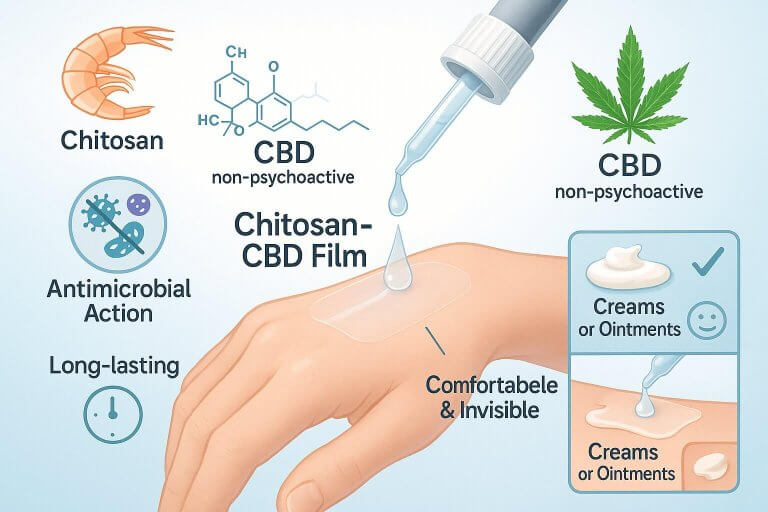A New Topical Antimicrobial Strategy
Citation: Veris A, Loskot J, Andrys R, Konecna K, Jandourek O, Snejdrova E. International Journal of Pharmaceutics, 2025. DOI link
Objective
The study aimed to develop and test a new type of topical (skin-applied) film that combines chitosan (a natural, biocompatible polymer) and cannabidiol (CBD) for treating skin infections caused by bacteria and fungi. The goal was to create a system that is effective, easy to use, and offers sustained drug release.
Significance
This study introduces a novel, dual-action topical therapy for skin infections, leveraging the natural antimicrobial properties of both chitosan and CBD. The film-forming system is easy to apply, comfortable, and could improve patient compliance compared to traditional creams or ointments. It may help in the fight against antibiotic-resistant bacteria and fungal infections.
It may help in the fight against antibiotic-resistant bacteria and fungal infections.
Background
- Film-Forming Systems (FFS): These are liquid or semi-liquid formulations that, when applied to the skin, dry quickly to form a thin, invisible film. This film acts as a reservoir, steadily releasing the medication over time. FFS are less greasy, more comfortable, and more discreet than creams or ointments.
- Chitosan: A substance derived from chitin (found in shellfish), chitosan is known for its film-forming, adhesive, and antimicrobial properties.
- CBD: A non-psychoactive compound from cannabis, CBD has anti-inflammatory, antioxidant, and antimicrobial effects. It is safe and already used in some approved medicines and many over-the-counter products.
Methodology
- Formulation: Researchers optimized the solvent system (ethanol-water ratio) to dissolve both chitosan and CBD, ensuring even distribution in the film.
- Characterization: The films were analyzed for their physical properties, drug release patterns, and microscopic structure using advanced techniques (DSC, rheology, Raman spectroscopy, microscopy).
- Antimicrobial Testing: The films were tested in vitro (in the lab) against several bacteria (both Gram-positive and Gram-negative) and fungi to assess their effectiveness.
Key Findings
- Successful Formulation: The team succeeded in creating a stable, homogenous film that incorporates both chitosan and CBD.
- Sustained Release: The film releases CBD gradually over time, which could reduce the need for frequent reapplication.
- Antimicrobial Efficacy: The films showed strong antimicrobial activity against a broad range of bacteria and fungi, thanks to the combined effects of chitosan and CBD.
- Mechanical & Cosmetic Advantages: The films were flexible, adhered well to skin, dried quickly, and were transparent, making them cosmetically appealing and comfortable for patients.
Limitations & Next Steps
- Laboratory Study: Results are from in vitro (lab) experiments; clinical trials in humans are needed to confirm safety and effectiveness.
- Formulation Optimization: Further work may refine the formulation for specific infections or patient groups.
Full Article
Read the full article here (DOI link)
Andrea Veris: Writing – review & editing, Writing – original draft, Visualization, Methodology, Investigation, Conceptualization. Jan Loskot: Writing – review & editing, Methodology, Investigation. Rudolf Andrys: Writing – review & editing, Methodology, Investigation. Klara Konecna: Writing – review & editing, Methodology, Investigation. Ondrej Jandourek: Writing – review & editing, Methodology, Investigation. Eva Snejdrova: Writing – review & editing, Supervision, Project administration,
